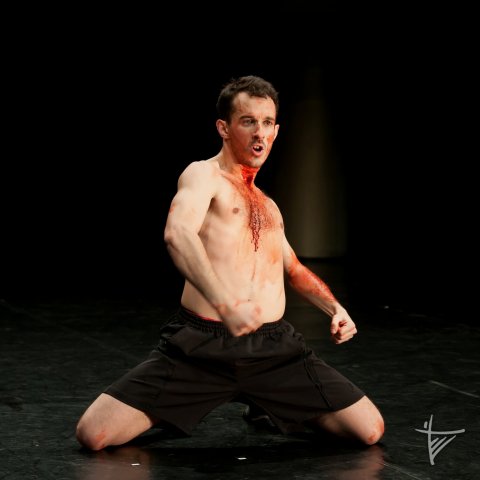
Art is a niche to show, to discuss, to confront the illegal. It has the ability to separate it from reality. Thus, under the name of art, the taboo becomes legal. How does contextualisation work? How does the human brain work? How do we use it?
On the altar of art, we are free to do what we cannot always do in life. Therefore, the alibi of art is freedom. At the same time, the fact that the boundaries are so relative also means that one cannot find one's limits. You might as well kill yourself on stage, they're watching. It's all a matter of context, the brain extracts essential elements of reality from the context.
"We started working with Gábor on several levels. I'm interested in his own personal past history and his feelings in the present, his relationship to dance. I am interested in the expectations and stereotypical characteristics of the male gender, the male role and character in different life situations and dance styles. Or the use of verbally interpretable content related to the theme - film excerpts, stories, poems, songs."
The solo series is a platform for close collaboration between creator and performer. Thanks to the genre of the solo, the portrait of the artist is drawn in the dancer's stage presence and performance, thus the joint work of two creative entities can become a portrait of a particular dancer of the KET.
Adrienn Hód's main profile is experimental movement, contemporary dance. She has worked as a choreographer in theatre performances, feature films (Son of Saul, Twin Hunters), commercials and fashion shows. Besides her creative work, she regularly teaches improvisation at the Budapest School of Contemporary Dance.
His work is concerned with the moving human body, highlighted from its cultural context, usually placed in an empty space. In the rehearsal space, she generates sensitive situations that give the dancers the space and confidence to create physicality. Her working method is based on improvisation, which is presented on stage in a rigorously structured form. She is not afraid to work with the unknown.
Adrienn Beaver was born in 1975. She graduated from the Budapest Dance School (founded by Iván Angelus in 1997) and was an active dancer until 2010. In 1995 she founded the OFF Company, which was followed by HODWORKS in 2007. In the same year, she was awarded a grant by the Műhely Alapítvány for the "Research of the Unknown" programme, and in 2008 she participated in the Hungarian-American art programme Meeting Points. In 2010 she was awarded a grant by the Trust for Mutual Understanding, and in 2011 she was awarded a residency at the Tanzfabrik in Berlin with the support of the Tempus Public Foundation. In 2012, he is a fellow of the Jardin d'Europe project, in 2013 he is a fellow of the Trafó House of Contemporary Arts, in autumn 2013 he is a fellow of the Headlands Centre for the Arts in San Francisco, in 2014 he is spending two weeks in Philadelphia with danceUSA/Philadelphia, with the exchange program of the Műhely Foundation. Basse danse was selected as one of the 20 most outstanding contemporary dance performances of the year in 2012, Pirkad in 2014, and Conditions of Mortality in 2015 by the international network Aerowaves. His work has been nominated for the Lábán Prize seven times, winning it twice, with Basse danse in 2012 and Pirkad in 2014.
Supporters: the National Cultural Foundation, Bethlen Téri Theatre, SÍN Cultural Centre, New Performing Arts Foundation
Stage: 10m x 10m (w x h)
black ballet carpet, black background
black coverts
Light: 8 profile lamps (ETC 25-50° 750W),
16 pcs 1 KW Pc + baffle
4 Fresner + baffle
1 PAR64 CP62
1 small foot
fog machine
Compulite Spark lightbox
Hang: 1 CD player
1 mixing console
Front, monitor speakers
Number of passengers: 1 male dancer
2 technicians
1 assistant
1 choreographer
Local demand: 2 illuminators
1 set of speakers
Other: the performance includes live animals, small dogs and fake blood
Stage construction: 5 hours
Stage resolution: 1 hour
Duration of the presentation: 45 min